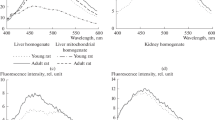Summary
The physical and chemical properties of the lipofuscin pigment have been studied in the neurons of C57 BL/10 mice of different ages. The results indicated the presence of two types of lipofuscin with different physical and chemical properties. The properties of these two types of lipofuscin have been discussed. It appears that the two types of lipofuscin found in young and old mice differ in their distribution, stainability, solubility, enzymatic activity, and fluorescence properties. It is suggested that these represent early and late stages in lipofuscin formation of the neurons. The pigment observed in animals deprived of Vitamin E was atypical in nature and did not conform to either of the types mentioned above.
Similar content being viewed by others
References
Barka, T., Anderson, P. J.: Histochemistry: theory, practice and bibliography, pp. 190–193. New York: Harper & Row, Inc. Hoeber Div., 1963.
Björkerud, S.: The isolation of lipofuscin granules from bovine cardian muscle, with observations on the properties of the isolated granules on the light and electron microscopic levels. J. Ultrastruct. Res., Suppl. 5, 1–49 (1964).
Bondareff, W.: Genesis of intracellular pigment in the spinal ganglia of senile rats. An electron microscope study. J. Geront.12, 364–369 (1957).
Chemnitius, K.-H., v., Machnik, G., Low, O., Arnich, M., Urban, J.: Versuche zur medikamentösen Beeinflussung altersbedingter Veränderungen. Exp. Path.4, 163–167 (1970).
Duncan, D., Nall, D., Morales, R.: Observations on the fine structure of old age pigment. J. Geront.15, 366 (1960).
Endicott, K. M., Lillie, R. D.: Ceroid, the pigment of dietary cirrhosis of rats: its chracteristics and differentiation from hemofuscin. Amer. J. Path.20, 149 (1944).
Edwards, J. E., Dalton, A. J.: Induction of cirrhosis of the liver and of hepatomas in mice with carbon tetrachloride. J. Nat. Cancer Inst.3, 19 (1942).
Gatenby, J. B.: The Golgi apparatus of the living sympathetic ganglion cells of the mouse, photographed by phase contrast microscopy. J. roy. micr. Soc.73, 61–81 (1953).
Gillman, J., Gillman, T., Brenner, S.: Porphyrin fluorescence in the livers of pellagrins in relation to ultra-violet light. Nature (Lond.)156, 689 (1945).
Glavind, J., Granados, H., Hartmann, S., Dam, H.: A histochemical method for the demonstration of fat peroxides. Experientia (Basel)5, 84–85 (1949).
Hendley, D. D., Mildvan, A. S., Reporter, M. C., Strehler, B. L.: The properties of isolated human cardiac age pigment. I. Preparation and physical properties. J. Geront.18, 144–150 (1963)a.
————: The properties of isolated human cardiac age pigment. II. Chemical and enzymatic properties. J. Geront.18, 250–259 (1963b).
Lillie, R. D., Draft, F. S., Sebrell, W. H.: Cirihosis of the liver in rats on a deficient diet and the effects of alcohol. Publ. Hlth. Rep. (Wash.)56, 1255 (1941).
Nandy, K.: Further effects of centrophenoxine on the lipofuscin pigments in the neurons of senile guinea pigs. Nature (Lond.)210, 313–314 (1966).
Pearse, A. G. E.: Histochemistry. Theoretical and applied, pp. 661–675. Boston: Little, Brown & C. 1964.
Reichel, W., Hollander, J., Clark, J. H., Strehler B. L.: Lipofuscin pigment accumulation as function of age and distribution in rodent brain. J. Geront.23, 71–78 (1968).
Samorajski, T., Keefe, J. R., Ordy, J. M.: Intracellular localization of lipofuscin age pigments in the nervous system. J. Geront.19, 262–276 (1964).
Sulkin, N. M.: Histochemical studies of the pigment in human autonomic ganglion cells. J. Geront.8, 435–448 (1953).
—: The properties and distribution of PAS-positive material in the nervous system of the senile dog. J. Geront.10, 135–144 (1955).
—, Srivanji, P.: The experimental production of senile pigments in nerve cells of young rats. J. Geront.15, 2–9 (1960).
Whiteford, R., Getty, R.: Distribution of lipofuscin in the canine and porcine brain as related to aging. J. Geront.21, 31–44 (1966).
Wolman, M.: Histochemistry of lipids in pathology. In: Handbuch, der Histochemie, Bd. V, S. 92–12. Stuttgat: G. Fischer 1964.
Author information
Authors and Affiliations
Additional information
Publication No. 1017 from the Basic Health Sciences Division of Emory University. Supported by Grant No. HD-04188 from the U.S. Public Health Service.
Rights and permissions
About this article
Cite this article
Nandy, K. Properties of neuronal lipofuscin pigment in mice. Acta Neuropathol 19, 25–32 (1971). https://doi.org/10.1007/BF00690951
Received:
Issue Date:
DOI: https://doi.org/10.1007/BF00690951




